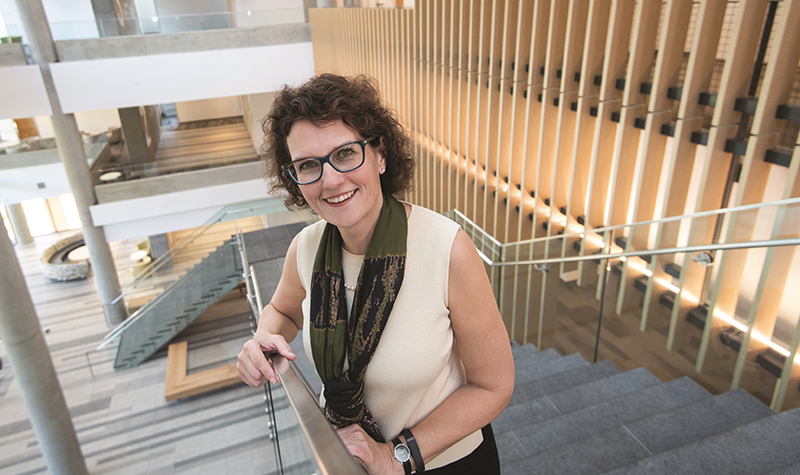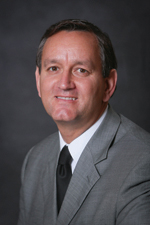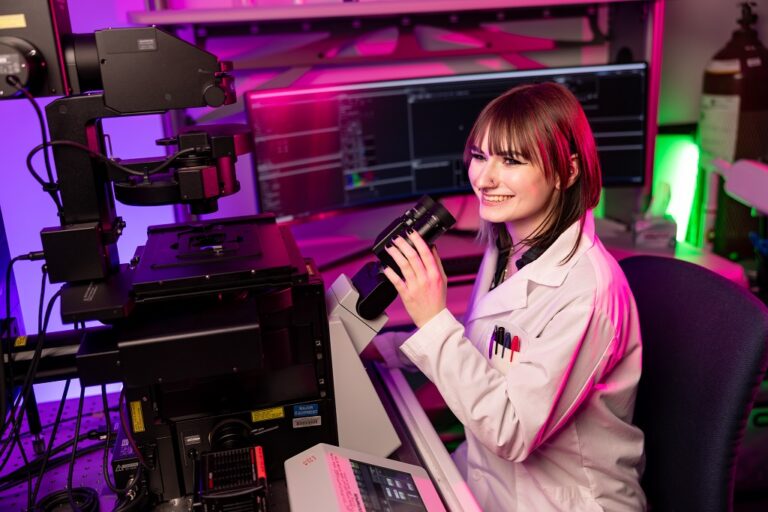When inspiration strikes
Life dedicated to research helps UND alumna Kathryn Uhrich, now a dean at UC-Riverside, satisfy her curious nature

Kathryn Uhrich, ’86, did not shout “Eureka!” or even utter an “Aha” when the inspiration for one of her most well-known discoveries came to her. She couldn’t, as she was in the middle of teaching a class in Organic Chemistry to a room full of undergraduates at Rutgers University.
“It hit me in class,” says Uhrich. “I was talking and I actually had to take a second to look away from the classroom and it’s like, oh my God, this is a great idea! How come I haven’t seen this before?”
While discussing how the students would soon be making aspirin in the lab, Uhrich was struck by the idea to make a polymerized aspirin that could take many forms that regular aspirin can’t. Uhrich says she took a deep breath, wrote down a few quick notes, then turned around and finished her lecture.
“Everybody has these unique wake-up-in-the-middle-of-the-night aha experiences – “I figured it out!” It was exactly one of those things for me; it just happened to be in front of 300 students.”
Uhrich says the idea was simple, but her research showed no one else had already come up with it. So she gave her notes to an undergraduate researcher and within a few weeks, the student had successfully created the first polymerized aspirin.
Undergrad research
It’s appropriate that Uhrich would turn to an undergrad to help with her research project since she received similar research opportunities as an undergraduate at the University of North Dakota in the mid-’80s. While studying Chemistry at UND, Uhrich worked at the Energy and Environmental Research Center studying the condensate produced by coal gasifiers. She says it was expected that she would not only collect and study the condensate samples, but also present her findings. She wasn’t happy about that at the time, but says those expectations turned out to be a blessing.
“They forced me to do it, and that helped me get visibility and to get confidence.”
Uhrich’s interest in research was piqued even earlier when, as a junior at Grand Forks Central High School, she took the advice of her Chemistry teacher and applied for a job at the Human Nutrition Research Center. For two summers before enrolling at UND, Uhrich helped with animal diet research where she realized that her curious nature was an asset.
“I’d always been a curious kid and asking questions is what science was all about and I just really got hooked. It just gave me a high level of comfort going into college and getting a degree in science.”
Researchers at the lab took notice of Uhrich’s intellectual curiosity and encouraged her to go to college. Uhrich says it was not a given that she would pursue a degree – neither of her parents had attended college – so the mentoring she received was “really critical” to her decision to enroll. It turned out to be the best decision she could make as Uhrich says she loved her UND experience from her science fiction writing class to chemistry and math classes.
“Looking back, I had a really great experience. I had an opportunity to do research at a couple different institutions. I had faculty in the Chemistry Department that supported it. All that stuff gives you confidence. It gives you an experience that I really didn’t appreciate how important it was until years later.”
Upon graduating after three-and-a-half years at UND in 1986, Uhrich received one more benefit from her campus experience: mentors who pushed her to apply to graduate school; going so far as to help her fill out and pay for her applications. Without that push, Uhrich says, she’s not sure she would have ended up in graduate school at one of the top schools in the country, Cornell University in upstate New York.

Patents pending
It was there that she earned a master’s and PhD in Organic Chemistry. It was also the place where she learned from the faculty about the importance of seeking patents for research work; she filed for her first patent while still a graduate student.
Uhrich’s experiences continued to reinforce that patent paradigm as she went from graduate school to postdoctoral research fellowships at Bell Laboratories and then the Massachusetts Institute of Technology. At MIT, she worked under Robert Langer, who is world renown for his work in biotechnology, and Cato Laurencin, a pioneer in the field of regenerative engineering. All along the way, Uhrich was drawn to translational science, the application of basic science to enhance human health and well-being.
“It’s kind of the ‘North Dakota way,”‘ Uhrich says. “It’s great to know what the secrets of the universe are, but what good does it do for you. I’m drawn to the understanding of the basic principles and how to implement them.”
Following her fellowship research, Uhrich landed at Rutgers University in New Jersey in 1995. It was here, while teaching 300 undergraduate students, that the idea for polymerized aspirin struck her. Regular aspirin breaks down quite quickly into salicylic acid which the liver then works to remove from the body. It’s the reason you must dose every four to six hours when taking aspirin for a headache. But Dr. Uhrich’s PolyAspirin uses polymers to create aspirin “beads” that are released slowly. These beads can be attached to surgical implants like a stent so that the anti-inflammation properties of aspirin aid the healing process at the source. Dr. Carmen Scholz, a University of Alabama at Huntsville professor of chemistry, said in advance of a lecture by Uhrich on campus recently, “With this trailblazing research, Dr. Uhrich single-handedly created a new branch of polymer chemistry: polymerized drugs.”
Uhrich received a patent for Poly Aspirin in 1997. She then set up a company, Polymerix Corporation, to create biodegradable delivery systems for nonsteroidal anti-inflammatory drugs and coatings for surgical implants.
Idea to implementation
Uhrich has amassed nearly 100 patents and has authored 150 peer-reviewed papers during her distinguished career, but even the most accomplished researcher can have a crisis of doubt when their theories become reality. Uhrich remembers having one when the first stent made with polymerized aspirin was implanted in a person in 1999. The surgery was done in Sao Paul, Brazil, and, in the hours before, Uhrich admits to “totally freaking out” about the possibility that the stent would do harm rather than good. Her husband, Jeff Holmes, had to remind her that the science was solid and years of work had gone into making sure it was safe.
“It’s just the intensity of the feeling of flipping from “This is totally freaking awesome” to “Oh my God, this is going in somebody’s heart. What if it kills them?” It was a remarkable moment.”
The patient, it should be noted, is still alive to this day.
College administration
These days, Uhrich is exploring a new career path in higher education administration. For the last three years, she has been the dean of the College of Natural and Agricultural Sciences at the University of California, Riverside. The college educates more than seven thousand undergrad and graduate students.
“I wanted to work with faculty and administrators and develop others the way that I had been developed,” says Uhrich of her decision to concentrate on administration.
Uhrich hasn’t totally abandoned research, though. In fact, she says she’s recently had “one of the best ideas I’ve ever had in my life.” But she’s having trouble getting anybody interested in it. She says it just goes to show that a good idea doesn’t mean it’s good in practice.
“Ideas are cheap,” she says with a laugh. “Implementation is the hard part.”
Uhrich has had more success than failure, though, and she hasn’t forgotten those who helped her along the way. It’s the reason she has been so passionate about mentoring undergraduates in her research labs and why she contributes to scholarship funds at Central High School and the University of North Dakota.
“I had people in my life who saw in me what I couldn’t see in myself and without them I wouldn’t be where I am today.”
 About the author:
About the author:
Milo Smith is the Senior Director of Public Relations for the UND Alumni Association & Foundation. For more information, contact Smith at milos@UNDalumni.net, or 701.777.0831.


